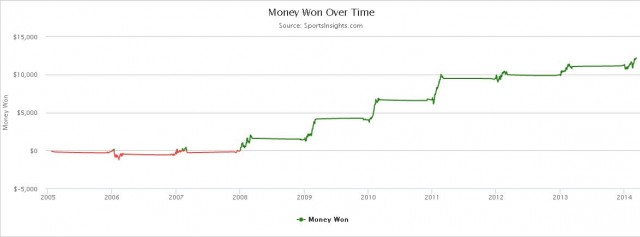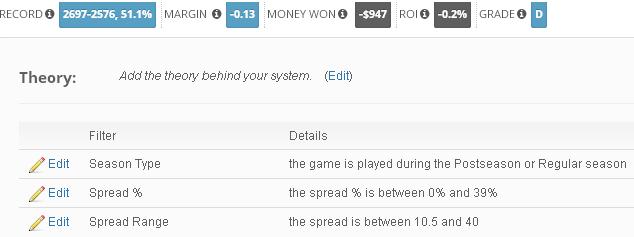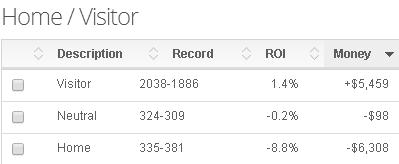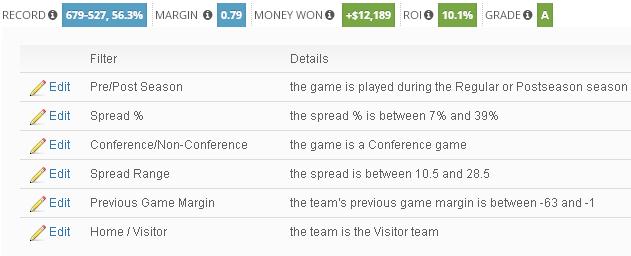
2014-15 College Basketball Betting Against the Public Report
Before the start of each season, we publish our annual betting against the public report which details the sweet spot for contrarian betting. By utilizing our public betting data from seven contributing sportsbooks, we’re able to see which teams the public is loading up on and then take the other side. You’ve heard the expression the house always wins? This allows you to consistently be on the same side as the house.
In the past, we’ve actually found that creating historically profitable contrarian College Basketball betting systems can be quite difficult. One of the main reasons for this is the high volume of games featuring two small conference teams or thoroughly mismatched opponents. These games typically receive very few bets which limits the effectiveness of betting against the public.
One advantage of betting against the public is taking teams with lines that have been artificially inflated by square bettors. For example, let’s pretend “Team A” opens as a 10-point favorite and receives 90% of spread bets. This type of lopsided action will force sportsbooks to adjust their odds in order to get equal action on each side — that way they can sit back and collect the vig risk-free.
In a heavily bet game, uninformed “square” bettors can actually move the line which allows sharp bettors to pounce on “Team B” at +11 instead of +10. Simply getting an extra point or half-point can improve your winning percentage by 2-4% over the long haul. But how can bettors know which contrarian teams are offering value to bettors? For that we utilized our Bet Labs software.
To create a winning system for College Basketball Betting Against the Public, we first created a new spread system and set the season type to include both regular season and postseason games. Our past research indicates that bettors have a slight advantage when betting against the public, but that edge is magnified when focusing on underdogs of more than 10 points. Although teams receiving less than 40% of spread bets actually have a losing record (10,534-10,619 ATS for -598.23 units), that winning percentage jumps to 51.1% when looking at dogs of 10.5+ points.
Although this basic two-filter system is not profitable enough to overcome the juice, it does display a clear edge for bettors. We’re also aware that outside of baseball (MLB), home-field advantage is vastly overrated in every major US sport. With this knowledge, we utilized the “home/visitor” filter to spotlight double-digit road dogs.
While home teams fitting this criteria are almost fade-worthy with a 335-381 (46.8%) ATS record, visitors have been far more impressive. Since 2005 road dogs of 10.5+ points that are receiving less than 40% of spread bets have gone 2,038-1,886 ATS for +54.59 units.
While this system has been historically profitable, it lacks the year-to-year consistency that we look for in a winning betting system. However, there are still two key filters that need to be added.
We’ve found that conference games tend to receive more bets than non-conference games and, as stated earlier, betting against the public is far more profitable in highly bet games. Even with this hypothesis driving our system, it was shocking to see the divergence between conference and non-conference games.
Although we expected that the return on investment (ROI) would rise when focusing on conference games, we anticipated that the overall units earned would drop off. Instead, the units earned nearly tripled from +54.56 to +143.86 while the ROI increased fivefold from 1.4% to 7.5%.
This system certainly fits our three criteria for a winning betting system as it has a strong driving hypothesis, massive sample size and consistent year-to-year results. Moreover, this system has averaged +17.8 units per season since the start of the 2007-08 campaign including a 75-60 ATS record last season. However, there is one more filter that can be used to improve almost any betting system.
Regardless of whether you’re buying stocks or betting on sports, the age-old adage of buying low and selling high is a reliable means of long-term returns. Often times that means betting on teams being ignored by other bettors — specifically teams coming off of a loss. When we set our “Previous Game Margin” filter between -1 and -63, our units won drops from +143.86 to +121.89, but since the number of past system picks is reduced by 37% we also see an improved ROI.
Our final system focuses on double-digit contrarian road dogs in conference games following a loss and has compiled a record of 679-527 ATS with +121.89 units won and a 10.1% ROI. Current Bet Labs customers can copy this system from the Think Tank to receive all current game matches via e-mail or text message.
We offer a 6-day Bet Labs trial for anybody interested in creating their own winning College Basketball betting systems, but Pro customers have full access to our Best Bets and Bet Signals along with real-time odds, public betting trends and much more.
Have any questions for the staff at Sports Insights? Utilize our live chat to speak with a customer service representative or e-mail us at help@sportsinsights.com.
3/5/15 Update: This system has gone 53-46 ATS (+4.24 units) this season and is now 734-575 ATS (+126.11 units, 10% ROI) overall.





adir
01/04/2015 at 4:10 pmOn todays nba card I have Detroit piston minus 3.5 and Toronto raptors as a pk. In your expert opinion are these two good pics
PJ
01/05/2015 at 8:26 amHi, sorry for the late response. We had Detroit -3 as well last night, so very well done on the win!
eric
01/14/2015 at 9:17 amGreat stuff as usual. Just curious, are the public support percentages on this website based on the overall cumulative % of the public that has bet on a given team OR is it based on the percentage of the public that is currently supporting a team at the current spread?
To clarify, say if I were to look at the percentage of the public backing a home 10 point favorite team around lunch time and see that this team was getting 70% of the public support. I would assume that the best course of action in this situation is to wait until closer to game time. Now this team is favored by 11 so I am getting a better line for the road dog. However, now SI says the home team is getting only 55% of support. Technically this no longer fits the system even though the line has actually moved in my favor.
BUT it really depends on whether the 55% of support is representative of overall cumulative public opinion or public opinion at the new 11 point spread. If the 55% only represents public opinion at the 11 point spread this could mean that cumulatively the favorite has been bet on by 60% of the public. In this case the strategy would actually still be applicable even though the favorite is only getting 55% of support at the new spread.
Sorry that was an earful, but any feedback would be very helpful in navigating this system.
David Solar
01/14/2015 at 1:47 pmOur public betting data is based on the overall percentage of bets placed on each side, regardless of what the line was at the time. However, if you look at the line histories on our live odds page, you can actually see the public betting trends at the time of each line move at every sportsbook.
eric
01/14/2015 at 4:08 pmOK cool thanks. I guess that means that when you look for a trend such as the one above, the data is reflecting closing lines and the public percentage is the overall percentage. So it probably makes sense to try to take advantage of this as close as possible to game time.
Thomas
03/09/2015 at 10:59 pmI was wondering two things. How do the lines change if a team is on a losing streak going into the game (lost 2 or more games coming in) and also want to make sure it is a true road game and neutral court games don’t count?
David Solar
03/10/2015 at 9:15 amWhen the team is on a losing streak of at least two games, this system has gone 489-390 ATS (+77.32 units won, 8.8% ROI). Also, we have a separate filter for neutral games, so these are all true road teams.